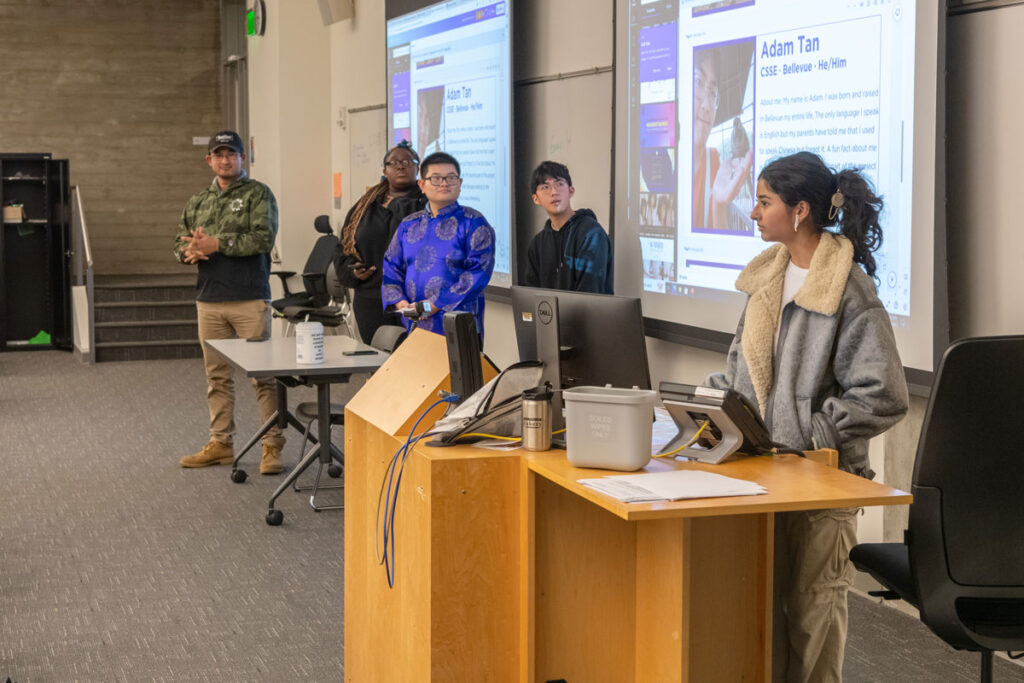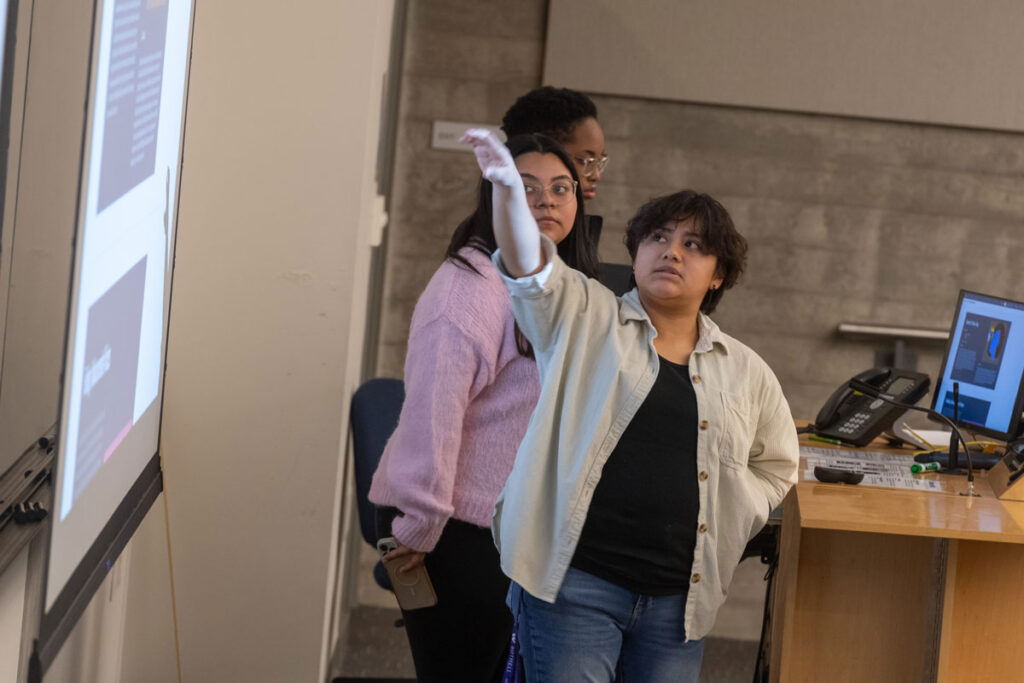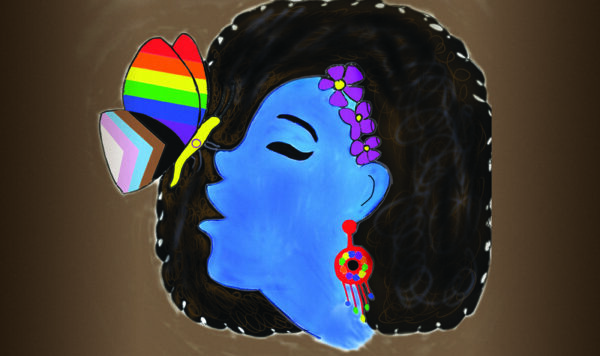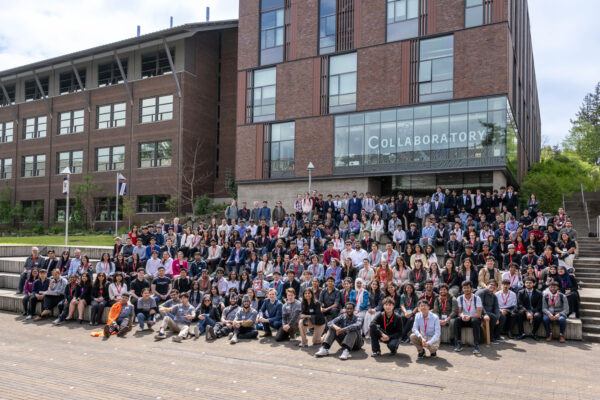Getting into college and making it through to graduation can be hard no matter a person’s circumstances. But for first-generation students — the first in their families to pursue a four-year degree — the challenges can be even greater.
Not only are these students without family members who can share advice about important tasks such as completing college applications or choices like selecting a major, but many are also without something just as critical to their success: permission to embrace their identities in a classroom setting.
“Until now, I had never felt truly seen or celebrated as an immigrant and first-generation student in an educational environment,” said first-year student Koket Gebiremichael. “I am not the same person I was before I took this class. I am now more confident in myself and in my culture.”
The class Gebiremichael referred to is part of the University of Washington Bothell’s Discovery Core Experience. DCX courses are designed to support first-year students in forming connections with communities of peers and scholars, as well as in familiarizing themselves with campus resources.
Titled Place & Displacement in the Americas, this DCX class is co-taught by Dr. Yolanda Padilla, associate professor, and Dr. Julie Shayne, teaching professor, both in the School of Interdisciplinary Arts & Sciences. This year the class also had a peer facilitator, Levi Gutiérrez, a senior majoring in Educational Studies and minoring in Gender, Women & Sexuality Studies.
“Levi really helped us put this class together and was a great resource for the first-year students as Levi has now gone through four years at the University and has insights into the experience that neither Yolanda nor I have,” Shayne said.
Dare to be different
Students in this class spent autumn quarter creating visual and written pieces about place and displacement. One of the primary goals of the course, Padilla said, was for “students to think about how people shape the places in which they live and, in the case of immigrants, reshape their new homes.”
Shayne added, “We also want students to think about how factors such as race, gender, social class and national heritage affect people’s experiences and places.”
Many of the students who enroll in this class are either immigrants or were raised by immigrant parents and can speak at least one other language besides English. “In a class with about 48 students, we typically have between 28 and 32 who are bi- or multi-lingual; that’s more than half of the class,” Shayne said. “We felt that we had this opportunity to create a project that celebrates language. We recognized that not every class could do something like this and ran with the idea.”
The project called for students to translate their assignments into one other language besides English. Padilla said the multilingual aspect was central to the project and to student learning. “A lot of the students talked about how they had never used their first language in a school setting or outside of the home at all,” she said. “For them, speaking their first language was really compartmentalized.
“This experience validated their culture,” she said, “and enabled them to understand it as something that could be important — and even crucial — in an academic setting.”
Additionally, Shayne explained, “Monolingual students’ learning was greatly enhanced as they watched their colleagues translate their words into different languages and saw the labor that went into that process. It made them truly cognizant of the richness of the UW Bothell community of which they are a part.”
Hip hop busts stereotypes
The first assignment in this course about displacement centered around genocide in the context of Indigenous people in the United States.
“There is a stereotype in the U.S. about Native Americans being a people of the past who are a part of history and do not exist in the present moment,” Padilla said. “We decided to have the students study rap music by Indigenous artists in part because the genre is so dominant now. The music is one example of how Native peoples are a vibrant and vital part of our current cultural moment.”
In collaboration with her group mates, first-year student Imaan Mohiuddin worked with “Home Runs” by artist Stella Standingbear.
“She is a Lakota musician from Utah’s Pine Ridge Reservation who has left an incredible mark on the music scene,” Mohiuddin said. “Her song ‘Home Runs’ was a defining piece that chronicles her journey from a 14-year-old SoundCloud rapper to shaping a distinctive blend of melodic alt-rap.”
She and her group mates chose Standingbear because her upbringing was similar to their own. “She also was a first-generation student, and we really resonated with that,” Mohiuddin said. “We could see ourselves in her as she also grew up in a predominately white, American neighborhood and felt very displaced.”
The group translated the song into Arabic, Mohiuddin’s native language. “It was definitely difficult because Arabic doesn’t directly translate to English,” she said. “I had to get help from my parents a few times, which was actually really nice as it helped me reconnect with my language.
“My parents were pleasantly surprised to learn I was using Arabic for a class assignment as that is something that had never happened before,” she added. “They were surprised the professors would care about our language enough to include it in a curriculum. I was, too, in the absolute best way.”

Endurance of the human spirit
Students were also asked to collaborate to create and then translate a “found poem” — a type of poetry created by taking words, phrases and sometimes whole passages from other sources and reframing them by making changes in spacing and lines or by adding or deleting text, thus imparting new meaning.
These found poems had to be based on the poetry of Claudia Castro Luna, a local Seattle poet who is from El Salvador. “She writes so powerfully about the experience of being a refugee from the civil war in El Salvador, which is central to the theme of place and displacement,” Shayne said.
This assignment made an impact on Mohiuddin who, prior to this, had never been a big fan of poetry. “Her poems were so moving. I fell in love with her work and ended up buying an entire book of her poetry,” she said.
As she explained, the poem Mohiuddin and her group mates wrote (below) “amplifies the jarring political shifts in Central America, vividly capturing the profound toll of corruption and distress on the region’s collective psyche.
“This found poem serves as a testament to the endurance of the human spirit in the face of political turmoil, urging recognition of the profound impact on individuals and communities ensnared in this tumultuous history.”
Found poem based on Seattle poet Claudia Castro Luna’s “Cipota Under the Moon,” by Daniel Singh, Melody Ekeh, Gia Nguyen, Imaan Mohiuddin & Adam Tan.
Cries of joy, Cries of War
We used to be Skipping and laughing,
Sparkling with hum and spunk
Echo of joy, cry of help
Sharing beers singing, we are alive
Memory of gold, rumbling our siren songs.
Then Death came
Necessity of Survival versus Grief of Homesickness
Tear your flesh, Ready to kill
Empathy for others
The third written aspect of the project involved writing a hypothetical letter to one of the undocumented immigrants the students “meet” after searching through the databases linked on the library research guide. Dani Rowland, a research librarian at the Campus Library, assisted students with this task and “played a key role in the assignment at large,” Padilla said.
The professors created this assignment because “we wanted the students to have empathy for undocumented people,” Shayne said. “We figured one of the ways to facilitate that was by communicating with an undocumented person and relating to their story.”
First-year student Karla Y Pacheco Ortiz and her group mates wrote to Siti Dyannie Rahmaputri, who was brought to the U.S. from Indonesia by her parents when she was 11 years old. She was preparing to enter college when the family faced the threat of being deported.
“My group mates and I related to her because all of our parents immigrated to the United States and have made multiple sacrifices for us, working low-income jobs just to survive,” Pacheco Ortiz said. “Education is very important to us and our families — just as it was to Siti and hers.”
Pacheco Ortiz said writing the letter with her group mates was an eye-opening experience. “I never imagined I would be in a classroom with so many students who share a similar background and experience with me,” she said. “I also never thought I would have professors who care about that or the hardships I have had to face because I am from an immigrant family.
“Having that support made a really big impact. It made me feel seen, like I mattered.”
I never imagined I would be in a classroom with so many students who share a similar background and experience with me. I also never thought I would have professors who care about that or the hardships I have had to face because I am from an immigrant family.
Karla Y Pacheco Ortiz, first-year student
Wave the welcome flag
Finally, students were asked to design a welcome flag that communicates that all genders and sexualities are welcome everywhere at UW Bothell.
First-year student Melanie Silvestre and her group mates created a flag “that makes everyone feel safe, included and, most importantly, welcome,” she said. “To make sure of this, we decided to include a little bit of everything — the African American hair type, the Pride flag that is within the butterfly (an animal that represents discovery and growth) and red earrings as a nod to Indigenous people.”
Both Padilla and Shayne were particularly taken with the flag. “I just love looking at it. It’s absolutely beautiful,” Padilla said. “Not only that, but it’s also incredibly well thought out.”
Mohiuddin and her group mates also put a lot of meaning into the design of their flag, which featured a background of flags from all 195 countries in the world.
“This was a testament to our open arms for individuals from all corners of the globe,” she said. “These flags represent not only different cultural backgrounds but also signify the beauty of cultural exchange — visually representing our collective hope for a seamlessly interacting community where individuals from varied cultures enrich each other’s experiences.”
Layered on top of the flags is a rainbow that Mohiuddin said “symbolizes our commitment to creating an LGBTQ+ positive environment and providing a safe and welcoming space for everyone, regardless of their sexual orientation or gender identity.”

Proud professors and peers
The professors are extremely proud of all the students in this course. “They all took the project so seriously and worked so hard over the quarter,” Shayne said. “I am also proud of how much pride they had in themselves and each other.”
Speaking as one of the students, Gebiremichael said, “I am really proud of our class as a whole, not just because of the work we put in but also because of how we showed up for one another. By the end of the quarter these people weren’t my classmates, they were my friends.
“I will remember this class and the people in it forever.”



